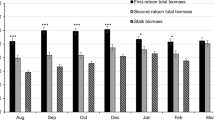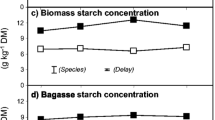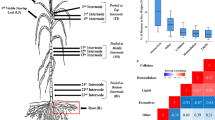Abstract
A better understanding of sugarcane and energy cane (Saccharum spp.) in biomass accumulation and carbohydrate composition can improve the knowledge of crop production sustainability and optimal utilization. The objectives of this study were to identify sugar composition and concentrations of stalk juice in sugarcane and energy cane grown on two sandy soils during ripening and to determine differences between the two types of canes in nonstructural and structural carbohydrate partitioning and concentrations in dry biomass for the mature plant-cane, first-ratoon, and second-ratoon crops. A field study was conducted at two locations with mineral (sand) soils in south Florida, USA, using two commercial sugarcane cultivars of CP 78-1628 and CP 80-1743 and two energy cane genotypes (US 78-1013 and US 84-1066) to determine their biomass yields and carbohydrate composition and concentrations. Averaged across the three crops and two locations, energy cane had significantly higher biomass yield, lower nonstructural carbohydrate (reducing sugars and sucrose) concentrations, and higher concentrations of cellulose, hemicelluloses, and lignin than sugarcane. Although there were no differences between sugarcane and energy cane in total carbohydrate concentration (839 to 842 g kg−1 DW), energy cane had 80% higher cellulose, 63% higher hemicelluloses, and 76% higher lignin; 69, 64, and 56% lower sucrose, glucose, and fructose concentrations, respectively, than sugarcane, when averaged across the three crops and two locations. These results can be useful for potential use of canes for both sucrose and cellulosic ethanol production on marginal sand soils to improve sustainability and profitability in the future.




Similar content being viewed by others
References
Byrt, C.S., C.P.L. Grof, and R.T. Furbank. 2011. C4 Plants as biofuel feedstocks: optimising biomass production and feedstock quality from a lignocellulosic perspective. Journal of Integrative Plant Biology 53: 120–135.
Carvalho-Netto, O.V., J.A. Bressiani, H.L. Soriano, C.S. Fiori, J.M. Santos, G.V.S. Barbosa, M.A. Xavier, M.G.A. Landell, and G.A.G. Pereira. 2014. The potential of the energy cane as the main biomass crop for the cellulosic industry. Chemical and Biological Technologies in Agriculture 1: 20. https://doi.org/10.1186/s40538-014-0020-2.
de Souza, A.P., A. Grandis, D.C.C. Leite, and M.S. Buckeridge. 2013. Sugarcane as a bioenergy source: history, performance, and perspectives for second-generation bioethanol. Bioenergy Research 7: 24–35.
Deren, C.W., B. Glaz, P.Y.P. Tai, J.D. Miller, and J.M. Shine Jr. 1991. Registration of ‘CP 80-1743’ sugarcane. Crop Science 31: 235–236.
Ezenwa, I.V., P.R. Newman, J.W. Dunckelman, and K.T. Morgan. 2005. Establishment and management of sugarcane on organic-amended vs. non-amended mineral soils. Journal of American Society of Sugar Cane Technologists 25: 107–108.
Fedenko, J.R., J.E. Erickson, K.R. Woodard, L.E. Sollenberger, J.M.B. Vendramini, R.A. Gilbert, Z.R. Helsel, and G.F. Peter. 2013. Biomass production and composition of perennial grasses grown for bioenergy in a subtropical climate across Florida, USA. Bioenergy Research 6: 1082–1093.
Gilbert, R.A., D.R. Morris, C.R. Rainbolt, J.M. McCray, R.E. Perdomo, B. Eiland, G. Powell, and G. Montes. 2008. Sugarcane response to mill mud, fertilizer, and soybean nutrient sources on a sandy soil. Agronomy Journal 100: 845–854.
Glasziou, K.T. 1961. Accumulation & transformation of sugars in stalks of sugar cane. Origin of glucose and fructose in the inner space. Plant Physiology 36: 175–179.
Grassi, M.C.B., and G.A.G. Pereira. 2019. Energy-cane and RenovaBio: Brazilian vectors to boost the development of Biofuels. Industrial Crops and Products 129: 201–205.
Inman-Bamber, N.G., P.A. Jackson, and M. Hewitt. 2011. Sucrose accumulation in sugarcane stalks does not limit photosynthesis and biomass production. Crop and Pasture Science 62: 848–858.
Jakob, K., F. Zhou, and A.H. Paterson. 2009. Genetic improvement of C4 grasses as cellulosic biofuel feedstocks. Vitro Cellular Developmental Biology - Plant 45: 291–305.
Kim, M., and D.F. Day. 2011. Composition of sugar cane, energy cane, and sweet sorghum suitable for ethanol production at Louisiana sugar mills. Journal of Industrial Microbiology and Biotechnology 38: 803–807.
Lam, E., J.J. Shine, J. Silva, M. Lawton, S. Bonos, M. Calvino, H. Carrer, M.C. Silva-Filho, N. Glynn, Z. Helsel, J. Ma, F. Richard-Jr, G.M. Souza, and J. Ming. 2009. Improving sugarcane for biofuel: engineering for an even better feedstock. Global Change Biology and Bioenergy 1: 251–255.
Leal, M.R.L.V. 2007. The potential of sugarcane as an energy source. Proceedings of International Society of Sugar Cane Technologists 26: 23–34.
Leal, M.R.L.V., and A. Da Silva Walter. 2010. Sustainability of the production of ethanol from sugarcane: the Brazilian experience. International Sugar Journal 112: 390–396.
Leon, R.G., R.A. Gilbert, and J.C. Comstock. 2015. Energycane (Saccharum spp. × Saccharum spontaneum L.) biomass production, reproduction, and weed risk assessment scoring in the humid tropics and subtropics. Agronomy Journal 107: 323–329.
Lingle, S.E. 1999. Sugar metabolism during growth and development in sugarcane internodes. Crop Science 39: 480–486.
Lingle, S.E., R.M. Johnson, T.L. Tew, and R.P. Viator. 2010. Changes in juice quality and sugarcane yield with recurrent selection for sucrose. Field Crops Research 118: 152–157.
Matsuoka, S., J. Ferro, and P. Arruda. 2009. The Brazilian experience of sugarcane ethanol industry. Vitro Cellular and Developmental Biology - Plant 45 (3): 372–381.
Matsuoka, S., A.J. Kennedy, E.G.D. dos Santos, A.L. Tomazela, and L.C.S. Rubio. 2014. Energy cane: Its concept, development, characteristics, and prospects. Advances in Botany Article ID 597275, 13 pages. http://dx.doi.org/10.1155/2014/597275.
McCray, J.M., K.T. Morgan, and L. Baucum. 2016. Nitrogen fertilizer recommendations for sugarcane production for sugar on Florida sand soils. UF/IFAS Extension, SS-AGR-401. http://edis.ifas.ufl.edu.
McCray, J.M., K.T. Morgan, L. Baucum, and S. Ji. 2014. Sugarcane yield response to nitrogen on sand soils. Agronomy Journal 106: 1461–1469.
McMillan, J.D. 1997. Bioethanol production: Status and prospects. Renewable Energy 10: 295–302.
Neves, M.F., M.J.A. Pinto, M.A. Coejero, and V.G. Trombin. 2011. Food and Fuel: The Example of Brazil. Wageningen, The Netherlands: Wageningen Academic Publishers.
Sandhu, H.S., and R.A. Gilbert. 2017. Production of biofuel crops in Florida: sugarcane/energy cane, SS-AGR-298, UF/IFAS Extension, http://edis.ifas.ufl.edu.
Sandhu, H.S., R.A. Gilbert, J.C. Comstock, V.S. Gordon, P. Korndorfer, N. El-Hout, and R. Arundale. 2015. Registration of ‘UFCP 74-1010’ sugarcane. Journal of Plant Registrations 9: 179–184.
Santchurn, D., K. Ramdoyal, M.G.H. Badaloo, and M.T. Labuschagne. 2014. From sugar industry to cane industry: Evaluation and simultaneous selection of different types of high biomass canes. Biomass and Bioenergy 61: 82–92.
Santchurn, D., M.G.H. Badaloo, M. Zhou, and M.T. Labuschagne. 2019. Genetic studies on sugar and fibre accumulation patterns among different types of energy canes in Mauritius. Sugar Tech 21: 879–890.
SAS Institute. 2010. SAS system for Windows release 9.3., SAS Inst., Cary, NC.
Shields, S., and R. Boopathy. 2011. Ethanol production from lignocellulosic biomass of energy cane. International Biodeterioration and Biodegradation 65: 142–146.
Somerville, C., H. Youngs, C. Taylor, S.C. Davis, and S.P. Long. 2010. Feedstocks for lignocellulosic biofuels. Science (Washington, DC) 329: 790–792. https://doi.org/10.1126/science.1189268.
Tai, P.Y.P., and J.D. Miller. 2002. Germplasm diversity among four sugarcane species for sugar composition. Crop Science 42: 958–964.
Tai, P.Y.P., J.D. Miller, B. Glaz, C.W. Deren, and J.M. Shine Jr. 1991. Registration of ‘CP 78-1628’ sugarcane. Crop Science 31: 236.
Tew, T.L., and R.M. Cobill. 2008. Genetic improvement of sugarcane (Saccharum spp.) as an energy crop. In Genetic Improvement of Bioenergy Crops, ed. W. Vermerris, 249–272. Berlin: Springer.
Tew, T.L., E.O. Dufrene, R.M. Cobill, D.D. Garrison, W.H. White, M.P. Grisham, Y.-B. Pan, B.L. Legendre, E.P. Richard Jr., and J.D. Miller. 2011. Registration of ‘HoCP 91-552’ sugarcane. Journal of Plant Registrations 5: 181–190.
Thammasittirong, S.N., P. Chatwachirawong, T. Chamduang, and A. Thammasittirong. 2017. Evaluation of ethanol production from sugar and lignocellulosic part of energy cane. Industrial Crops and Products 108: 598–603.
van Heerden, P.D.R., R.A. Donaldson, D.A. Watt, and A. Singels. 2010. Biomass accumulation in sugarcane: unravelling the factors underpinning reduced growth phenomena. Journal of Experimental Botany 61: 2877–2887.
VanWeelden, M., R. Rice, W. Davidson, and S. Swanson. 2018. Sugarcane variety census: Florida 2016. Sugar Journal 81 (2): 12–24.
Waclawovsky, A.J., P.M. Sato, C.G. Lembke, P.H. Moore, and G.M. Souza. 2010. Sugarcane for bioenergy production: an assessment of yield and regulation of sucrose content. Plant Biotechnology Journal 8: 263–276.
Wang, J., S. Nayak, K. Koch, and R. Ming. 2013. Carbon partitioning in sugarcane (Saccharum species). Frontier Plant Science 4: 201. https://doi.org/10.3389/fpls.2013.00201.
Watt, D.A., and M.D. Cramer. 2009. Post-harvest biology of sugarcane. Sugar Tech 11: 142–145.
Woodard, K.R., and G.M. Prine. 1993. Dry matter accumulation of elephantgrass, energycane, and elephantmillet in a subtropical climate. Crop Science 33: 818–824.
Woodard, K.R., G.M. Prine, and S. Bachrein. 1993. Solar energy recovery by elephantgrass, energycane, and elephantmillet canopies. Crop Science 33: 824–830.
Yang, X., J. Todd, R. Arundale, J.B. Binder, Z. Luo, M.S. Islam, S. Sood, and J. Wang. 2019. Identifying loci controlling fiber composition in polyploid sugarcane (Saccharum spp.) through genome-wide association study. Industrial Crops and Products 130: 598–605.
Zhao, D., B. Glaz, and J.C. Comstock. 2013. Sugarcane leaf photosynthesis and growth characters during development of water-deficit stress. Crop Science 53: 1066–1075.
Zhao, D., C.T. MacKown, P.J. Starks, and B. Kindiger. 2010. Rapid analysis of nonstructural carbohydrate components in grass forage using microplate enzymatic assays. Crop Science 50: 1537–1545.
Zhao, D., M. Irey, C. LaBorde, and C.-J. Hu. 2017. Identifying physiological and yield-related traits in sugarcane and energy cane. Agronomy Journal 109: 927–937.
Zhao, D., M. Irey, C. LaBorde, and C.-J. Hu. 2019. Physiological and yield characteristics of 18 sugarcane genotypes grown on a sand soil. Crop Science 59: 2741–2751.
Acknowledgements
Authors thank Philip Aria and Miguel Baltazar for their valuable technical assistance in data collection. Authors also appreciate Carlos Romagosa (Florida Crystals Corporation) and Lee Davis (U.S. Sugar Corporation) for help on planting, field management, and harvest. Use of trade or commercial product names is for informational purpose only and does not imply endorsement by the United States Department of Agriculture to the exclusion of any other product that may be suitable.
Author information
Authors and Affiliations
Contributions
D. Zhao contributed to conception and design of the experiment, and analyzed and interpreted data, and prepared the first version of manuscript. A. Momotaz finalized the manuscript and integrated all ideas and comments from other authors and peer reviewers. C. LaBorde and M. Irey coordinated in experimental design, field plot arrangement, and manuscript review.
Corresponding author
Ethics declarations
Conflict of interest
The authors declare no conflict of interest.
Additional information
Publisher's Note
Springer Nature remains neutral with regard to jurisdictional claims in published maps and institutional affiliations.
Rights and permissions
About this article
Cite this article
Zhao, D., Momotaz, A., LaBorde, C. et al. Biomass Yield and Carbohydrate Composition in Sugarcane and Energy Cane Grown on Mineral Soils. Sugar Tech 22, 630–640 (2020). https://doi.org/10.1007/s12355-020-00807-0
Received:
Accepted:
Published:
Issue Date:
DOI: https://doi.org/10.1007/s12355-020-00807-0




